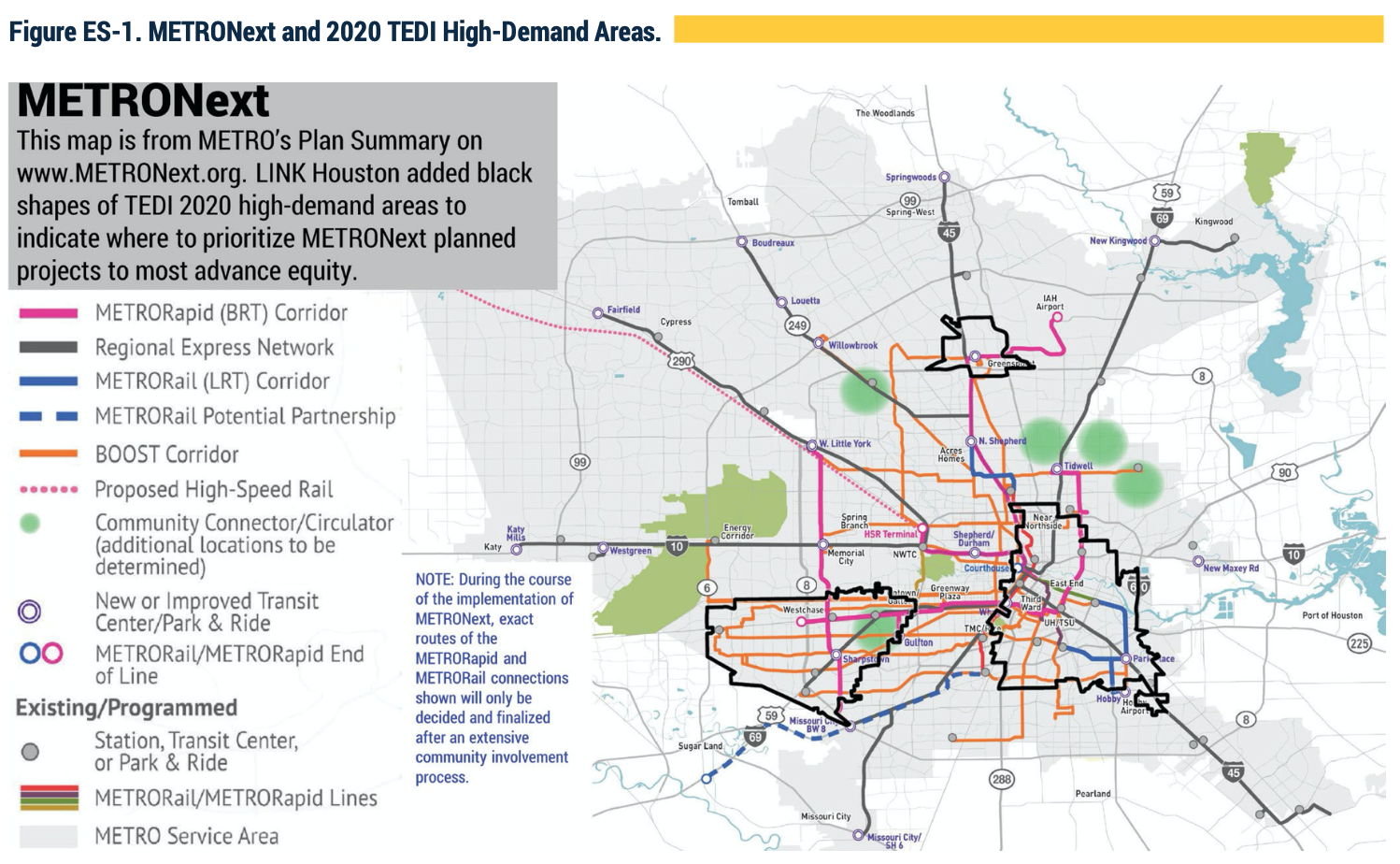Overview video
Stories
UH Student
Dwyannetta Coleman
Xochitl Avalos
Gayle Waden
Keith Downey
Explore the report
Executive Summary
Public transit connects people to opportunity and advances equity when it exists in certain places and operates a quality service. Achieving equity in and through transit refers to the fair and just distribution of benefits and burdens of transit services and infrastructure across communities. Equity in Transit: 2020 examines how to improve Metropolitan Transit Authority of Harris County, TX (METRO) transit services, particularly for people who ride the local bus.
Over 4.5 million people live in the METRO service area and 69% are people of color (e.g., Black, Indigenous, people of color). The service area also includes:
- 218,000 households living in poverty
- 304,000 households with one or more persons with a disability
- 91,000 households with no vehicle
- 59,000 people commuting primarily by transit
- 430,000 jobs paying less than $15,000 annually
The 2020 update to the Transportation Equity Demand Index (TEDI) found the eastern and southeastern area of Houston, southwest area of Houston, and Greater Greenspoint high-demand areas continue to warrant strategic and disproportionately high investments. About 867,000 people in Houston live in these three high-demand areas. Ridership on local bus and light rail never dipped below 43% of normal ridership during the deepest depths of the COVID-19 pandemic, a clear indicator of the important role local transit plays in connecting essential workers to jobs and the vital nature of many other trips.
The four principal recommendations from the 2018 baseline report remain relevant and constitute the core recommendations in 2020: frequency, span of service, reliability, and accessibility. METRO made meaningful progress in key aspects of the four recommendations in 2019 and 2020, but many opportunities and much work remain, such as:
- Increase frequency by continuing to prioritize the regularity of local bus routes during the COVID-19 pandemic; ensuring all system-wide service changes in 2021 prioritize the local bus network, whose ridership is most swiftly recovering; prioritizing implementation of METRONext projects serving people in TEDI high-demand areas; and advancing Bus Operations Optimized System Treatments (BOOST) improvements on local bus routes, prioritized by TEDI rating (i.e., the combined 25-Richmond and 50-Broadway corridor and the 2-Bellaire corridor as potential next priorities).
- Extend service hours by strategically increasing the span on routes serving essential workers and communities with high demand for equity in transit (where feasible given COVID-19’s budgetary implications).
- Improve reliability for on-time buses by focusing on making expected and real-time bus schedule information readily available to riders, especially given the exceptional circumstances of COVID-19.
- Pursue accessibility and other transit stop upgrades by continuing efforts to ensure every bus stop and station is brought into a full state of accessibility; prioritizing improvements in communities with high demand for equity; completing a substantial portion of METRONext funded bus stop accessibility improvements in 2021; and reevaluating the process and metrics governing how bus stops qualify for necessary amenities (i.e., shelter, seating, lighting, trash bins, etc.), with special consideration of transfer points and stops with off-peak service frequency of 30-minutes or longer.
METRO and partners should continue equitable implementation of METRONext by prioritizing projects on the local bus network in the near-term, specifically in the three TEDI high-demand areas (refer to Figure ES-1). Doing so will advance equity by improving transportation options for people walking, rolling, biking, and riding local transit in areas where the population is 88% people of color. Given the economic challenges created by COVID-19 on individuals and families, local bus improvements are the best way to quickly, but substantially, improve access to opportunity in Houston.
Note: www.METRONext.org contains a complete summary of each METRONext plan element listed in the legend in Figure ES-1.
The report and related information are available on www.LINKHouston.org by searching for “Equity in Transit: 2020.” The webpage also includes an interactive StoryMap summary, the Executive Summary in Spanish, and links to access TEDI data in an Excel spreadsheet and ArcGIS geodatabase formats.







